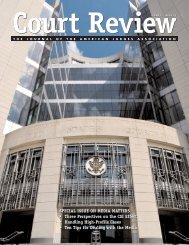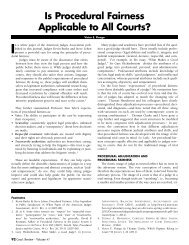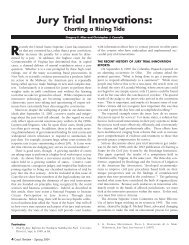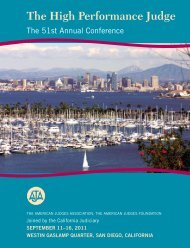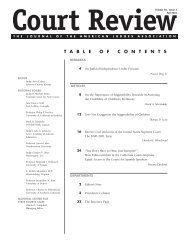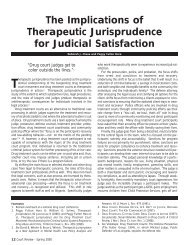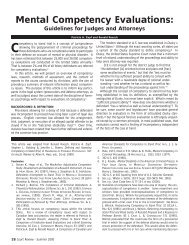Special Issue on Procedural Fairness - American Judges Association
Special Issue on Procedural Fairness - American Judges Association
Special Issue on Procedural Fairness - American Judges Association
- No tags were found...
You also want an ePaper? Increase the reach of your titles
YUMPU automatically turns print PDFs into web optimized ePapers that Google loves.
Several of the court attenders expressed c<strong>on</strong>cerns abouthow to appropriately integrate children into hearings. Onechild, age 14, reported difficulty understanding what was happeningduring the hearing. She said “they should simplify it forkids because a lot of the words were very technical.” That samechild also expressed c<strong>on</strong>cerns about being upset by having tosee other members of her family at court. In fact, she had notattended the hearing in questi<strong>on</strong> because she had heard hermother was going to be there, though she had attended previoushearings. Similarly, another child expressed c<strong>on</strong>cerns shewas not able to tell the judge what she really thought becauseshe did not want to upset her mother, who was also present atthe hearing. It is interesting to note that the same childrenwho expressed these c<strong>on</strong>cerns also expressed positive attitudesabout the value of attending court and their percepti<strong>on</strong>s of fairnessof the court procedure. The children who felt c<strong>on</strong>cernsabout family members actively made decisi<strong>on</strong>s to protectthemselves from situati<strong>on</strong>s they found stressful or painful (notattending a hearing; not being forthcoming in fr<strong>on</strong>t of themother). These comments suggest that if children are to benefitfrom the court participati<strong>on</strong>, including feeling their perspectiveis important and the process is fair, it may be importantto give children the opti<strong>on</strong> to choose not to attend theirhearing. The comments also suggest attorneys or guardians adlitem have a role to play in “translating” the technical languageof the courtroom.This project builds <strong>on</strong> a small, but growing body of researchabout children’s percepti<strong>on</strong>s regarding their participati<strong>on</strong> inlegal and quasi-legal proceedings. Surveys of children who arein or who were in the foster care system have generally foundthese children want more participati<strong>on</strong> in the decisi<strong>on</strong>-makingabout their lives. 23 Foster children have reported they wishedthey were asked their opini<strong>on</strong>s about decisi<strong>on</strong>s that affectedthem, and a major c<strong>on</strong>cern of theirs was their percepti<strong>on</strong> thatthey lacked c<strong>on</strong>trol over decisi<strong>on</strong>s being made about them. 24In England and Wales, The Children’s Act of 1989 requirescourts and local authorities to obtain “looked after” (i.e., foster)children’s views and to take those views into c<strong>on</strong>siderati<strong>on</strong>when making decisi<strong>on</strong>s regarding their care. Several studieshave explored children’s percepti<strong>on</strong>s of their required participati<strong>on</strong>in review meetings, which are formal reviews that includerepresentatives of various agencies, parents, and foster parents.The studies typically involve self-reports of small numbers ofchildren that are c<strong>on</strong>venience samples. The largest studyinvolved interviews with 47 children between the age of 8 and12. 25 Most of the children wanted more preparati<strong>on</strong> before themeetings to learn what the meeting would be like, who wouldbe there, and what would be discussed. Most of the childrenfelt satisfied with the amountof support they received at themeetings. A quarter of thechildren felt that they spoke “alot” at the meetings, the restfelt they spoke “some” or “a little.”Most of the children whospoke felt they were listened to“a lot” by the adults. In c<strong>on</strong>trast,few of the children feltthey had “a lot” of influenceover decisi<strong>on</strong>s that were made.Surprisingly, half the childrenAnother focusof research[has been <strong>on</strong>]child witnessestestifying abouttheir allegati<strong>on</strong>sof sex abusevictimizati<strong>on</strong> incriminal court.reported they liked the meetings <strong>on</strong>ly “a little,” describing themas boring, scary, upsetting, or embarrassing. Some childrenexpressed the views that they didn’t like being put <strong>on</strong> the spotor having their lives discussed by strangers.PARTICIPATION AS VICTIM-WITNESSESAnother focus of research regarding children’s participati<strong>on</strong>in legal proceedings involves child witnesses testifying abouttheir allegati<strong>on</strong>s of sex abuse victimizati<strong>on</strong> in criminal court.The seminal work in this area was a study by Goodman andher associates that followed children through the criminalcourt process, including the experience of testifying for thosechildren whose cases went to trial. Sixty children who went <strong>on</strong>to testify were compared to 75 c<strong>on</strong>trol children whose casesdid not go to trial. 26 The study’s main findings were that the“testifiers” exhibited more behavioral disturbance than the“n<strong>on</strong>-testifiers” seven m<strong>on</strong>ths following their testim<strong>on</strong>y, especiallyif they had to take the stand numerous times, did nothave maternal support, and did not have their statements corroborated.The adverse effects diminished after the prosecuti<strong>on</strong>was complete. A l<strong>on</strong>g- term follow up of these children(average elapsed time of over 12 years from trial) by Quas andher colleagues found victim-witnesses who had testified perceivedthe legal system as fairer than those victim-witnesseswho had not had their day in court. 27 The researchers surmisedthose children who more fully participated were more satisfiedwith the legal system, but they also could not rule out the possibilitythat the children who did not end up testifying hadtheir cases resolved through plea bargains and that there mayhave been less severe sentences for the alleged perpetrators inthose cases.PARTICIPATION IN CHILD CUSTODY DECISION-MAKINGAnother major trend in increasing children’s participati<strong>on</strong> inlegal proceedings involves custody determinati<strong>on</strong>s in divorces.23. E.g., Mary C. Curran & Peter Pecora, Incorporating thePerspectives of Youth Placed in Family Foster Care, in THE FOSTERCARE CRISIS: TRANSLATING RESEARCH INTO POLICY AND PRACTICE 99(Patrick A. Curtis. eds., 1999); Krinsky, supra note 7.24. E.g., TRUDY FESTINGER, NO ONE EVER ASKED US: A POSTSCRIPT TOFOSTER CARE (1983); Judy Cashmore, Promoting the Participati<strong>on</strong>of Children and Young People in Care, 26 CHILD ABUSE & NEGLECT837 (2002).25. Nigel Thomas & Claire O’Kane, Children’s Participati<strong>on</strong> in Reviewsand Planning Meetings When They are “Looked After” in MiddleChildhood, 4 CHILD & FAM. SOC. WORK 221 (1999).26. Gail S. Goodman et al., Testifying in Criminal Court: Emoti<strong>on</strong>alEffects <strong>on</strong> Child Sexual Assault Victims, 57 MONOGRAPHS OF THESOCIETY FOR RESEARCH IN CHILD DEVELOPMENT (1992).27. Jodi A. Quas et al., Childhood Sexual Assault Victims: L<strong>on</strong>g-TermOutcomes After Testifying in Criminal Court, 70 MONOGRAPHS OFTHE SOCIETY FOR RESEARCH IN CHILD DEVELOPMENT (2005).Court Review - Volume 44 39



